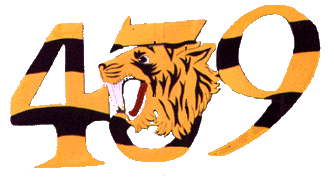Clouds
likewise interfered with observation of results on a dive bombing show
the next day. Bob Laurence led his section as far as Munster before the clouds thinned out
enough to expose the ground. Seeing the marshalling yards in the city were teeming with activity, Bob took his pilots down through streams of flak and deposited eight bombs in the congested yards.
The only definite result that could be noted was volumes of brown smoke belching from a warehouse. And, finally, a section led by W/C Grant made two hits on an embankment, with probable damage to the rails, near Aalten by the Dutch border. Two non operational
sorties during this period also proved exciting.
On the 17th, a day of unusual enemy air activity, F/O Walt Kubicki while up on an A and E test had a few uncomfortable moments due to the hostile attitude of some Allied fighter aircraft that seemed doubtful of
the Typhoon's identity. F/O Laurence, who was in the air at the same time, discovered the cause of the fighters agitation. Flak bursts over Eindhoven attracted his attention and, upon investigation, he was surprised to find four Me. 262s racing along in line astern. By jamming the throttle open and keeping inside the
Huns' orbit, Bob was able to remain within sight and range of the jets until three dived to release their bombs on a small village.
|
Intentionally
left blank
|
Intentionally
left blank
|
The fourth lagged a bit behind the others and the Typhoon pilot got in a burst from 800 yards range. A stream of smoke from the jets raised momentary hopes of a hit, but it was soon obvious that the enemy pilot was merely
"turning up the burners" and within a short time the Messerschmitt had pulled out of sight. Laurence continued to patrol
for the next 15 minutes, catching a few glimpses of the enemy without being able to get within range again.
The week of the 16th to the 22nd was particularly foggy, the squadron's only operations being two weather recces. The pllots fidgeted at this inactivity, for 100 miles to the south a critical situation had developed. Under cover of the oppressive fog which grounded Allied aircraft for days the Nazis had launched a counter offensive through the Ardennes that culminated in the "Battle of the
Bulge" around Bastogne.(1) The offensive had been under way a week before the weather permitted the Typhoons to join in the fighting in support of the hard pressed American troops.
(1) For some days the situation appeared to be so critical that all personnel at Eindhoven were ordered to carry small arms whether on or off
duty.
|
|
From 23 December to 13 January No. 439 Squadron's primary
commitment was armed recces to strafe enemy movements in the vital area from Duren and Euskirchen to the battle front around Malmedy, St. Vith and
Houffalize.
F/L Johnny Carr led the first recce into the new battle area to the south and set the pattern as it were for these operations by destroying one vehicle and damaging half a dozen more. The dense ground haze hampered strafing, and the enemy's ack ack defences offered hot opposition. B.78 had a taste of the Luftwaffe's counter
air activity that day when two bombs were dropped on the airfield, making the huts shake. A flying bomb also buzzed over.
  
Copyright
©1998-2016 Michael T. Melnick. All rights reserved
the
unofficial homepage of  Tiger
Squadron Tiger
Squadron
.
.
|